As the world of music education continues to evolve, it’s essential to keep up with the latest trends in the industry. Whether you’re a music teacher, student, or enthusiast, understanding the most significant developments in music education can help you stay informed, inspired, and on the cutting edge of the field.
Today, several trends are shaping the future of music education, from the growing importance of technology in the classroom to the need for more diverse and inclusive approaches to the teaching of music.
The rise of technology in music education and its impact on teaching and learning
Technology has become increasingly important in modern music education, revolutionising the way students learn and teachers teach. From digital tools to online learning platforms, technology has opened up many new possibilities to music educators.
With the rise of digital audio workstations (DAWs) and other music software, students can now create and produce music on their computers, expanding their creativity and musical skill sets. Popular DAWs such as GarageBand, Logic Pro, and Ableton Live provide a powerful and user-friendly interface for composing, arranging and mixing music.
Additionally, technology has made music education more accessible, allowing students from across the globe to connect and learn from each other.
Examples of how technology is being used in music education
The use of technology in music education has taken many forms, with digital tools and online learning platforms being among the most popular. Digital audio workstations such as Logic Pro, Ableton Live, and Pro Tools have become standard tools for music production and composition, allowing students to create and produce their own music at home. Online learning platforms such as Udemy, Skillshare, and Coursera offer a wealth of music courses and tutorials, covering everything from music theory to composition to music production. Additionally, social media is now a powerful tool for music education, allowing students and teachers to connect and share their work with a global audience.
Virtual instruments
Virtual instruments are gaining traction amongst students these days as they replicate the sounds of real instruments and allow students to play them using MIDI controllers or computer keyboards. Virtual instruments provide a cost-effective way to explore a wide range of musical sounds, including orchestral instruments, synthesizers, drums and more.
Apps such as GarageBand, Soundtrap and BandLab offer features similar to DAWs, allowing students to easily create, record and share music on their mobile devices. Naxos Music Library is the largest classical music academic resource in the world. The streaming platform offers nearly 3 million tracks on over 170,000 separate recordings, all advert-free and with no personal data required for institutional logins. All major classical music labels are featured, and a sophisticated search engine allows you to find what you need without the need for complicated search terms.
Teachers can use conferencing tools such as Zoom, Google Meet and Microsoft Teams for remote music education which enables them to conduct virtual lessons and ensembles. This can allow for collaboration with peers and, at the same time, the opportunity to receive real-time feedback from instructors.

The world of music education is always evolving and, as technology advances and society changes, so too do trends in music education. In the coming years, we can expect to see even more innovation and change in the field, as educators and students continue to adapt to new technologies and approaches. Emerging trends in music education include the use of artificial intelligence and virtual reality in music teaching and learning, as well as the integration of music and other subjects, such as science and technology.
As music education continues to evolve, it will be important for educators to stay abreast of ever changing trends and adapt their teaching methods to meet the needs of today’s students. This may involve incorporating new technologies and teaching approaches, as well as continuing to focus on inclusivity, cultural diversity and social and emotional learning. Ultimately, the future of music education will be shaped by the needs of students and the broader trends in education and society as a whole, and it will be up to educators and music industry leaders to help guide this evolution.









